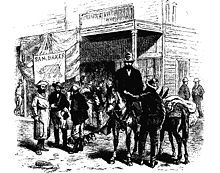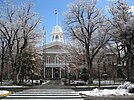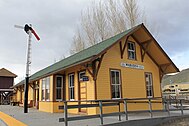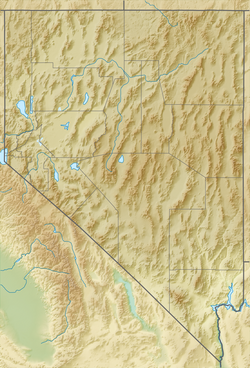
A | B | C | D | E | F | G | H | CH | I | J | K | L | M | N | O | P | Q | R | S | T | U | V | W | X | Y | Z | 0 | 1 | 2 | 3 | 4 | 5 | 6 | 7 | 8 | 9
Carson City | |
|---|---|
| Consolidated Municipality of Carson City | |
| Nicknames: Carson, CC, The Capitol | |
| Motto: Proud of its Past...Confident of its Future | |
 Location within Nevada | |
| Coordinates: 39°9′52″N 119°46′1″W / 39.16444°N 119.76694°W | |
| Country | United States |
| State | Nevada |
| Founded | 1858 |
| Named for | Kit Carson |
| Government | |
| • Mayor | Lori Bagwell |
| Area | |
| • Total | 157.12 sq mi (406.94 km2) |
| • Land | 144.53 sq mi (374.34 km2) |
| • Water | 12.59 sq mi (32.59 km2) 8.0% |
| Elevation | 4,682 ft (1,427 m) |
| Population (2020) | |
| • Total | 58,639 |
| • Density | 405.71/sq mi (156.65/km2) |
| Time zone | UTC−8 (Pacific) |
| • Summer (DST) | UTC−7 (Pacific) |
| ZIP code | 89701–89706, 89711–89714, 89721 |
| Area code | 775 |
| GNIS feature ID | 863976[2] |
| Website | carson.org |
| Reference no. | 44 |
Carson City is an independent city and the capital of the U.S. state of Nevada.[3] As of the 2020 census, the population was 58,639, making it the 6th most populous city in the state. The majority of the city's population lives in Eagle Valley, on the eastern edge of the Carson Range, a branch of the Sierra Nevada, about 30 miles (50 km) south of Reno. The city is named after the mountain man Kit Carson. The town began as a stopover for California-bound immigrants, but developed into a city with the Comstock Lode, a silver strike in the mountains to the northeast. The city has served as Nevada's capital since statehood in 1864; for much of its history it was a hub for the Virginia and Truckee Railroad, although the tracks were removed in 1950.
Before 1969, Carson City was the county seat of Ormsby County. That year, after a referendum approved merging the city and the county, the state legislature issued a revised city charter that merged them into the Consolidated Municipality of Carson City.[4] With the consolidation, the city limits extend west across the Sierra Nevada to the California state line in the middle of Lake Tahoe. Like other independent cities in the United States, it is treated as a county-equivalent for census purposes.
History


The Washoe people have inhabited the valley and surrounding areas for about 6,000 years.[5]
The first European Americans to arrive in what is now known as Eagle Valley were John C. Frémont and his exploration party in January 1843.[6] Fremont named the river flowing through the valley Carson River in honor of Kit Carson, the mountain man and scout he had hired for his expedition. Later, settlers named the area Washoe, in reference to the indigenous people.[7]
By 1851, the Eagle Station ranch along the Carson River was a trading post and stopover for travelers on the California Trail's Carson Branch, which ran through Eagle Valley. The valley and trading post received their name from a bald eagle that was hunted and killed by one of the early settlers and was featured on a wall inside the post.
As the area was part of the Utah Territory, it was governed from Salt Lake City, where the territorial government was headquartered. Early settlers bristled at the control by Mormon-influenced officials and desired the creation of the Nevada territory. A vigilante group of influential settlers, headed by Abraham Curry, sought a site for a capital city for the envisioned territory.[8] In 1858, Abraham Curry bought Eagle Station and the settlement was thereafter renamed Carson City.[9] Curry and several other partners had Eagle Valley surveyed for development. Curry decided Carson City would someday serve as the capital city and left a 10-acre (40,000 m2) plot in the center of town for a capitol building.
After gold and silver were discovered in 1859 on nearby Comstock Lode, Carson City's population began to grow. Curry built the Warm Springs Hotel a mile to the east of the city center. When territorial governor James W. Nye traveled to Nevada, he chose Carson City as the territorial capital, influenced by Carson City lawyer William Stewart, who escorted him from San Francisco to Nevada.[10] As such, Carson City bested Virginia City and American Flat. Curry loaned the Warm Springs Hotel to the territorial Legislature as a meeting hall. The Legislature named Carson City to be the seat of Ormsby County and selected the hotel as the territorial prison, with Curry serving as its first warden. Today, the property is still part of the state prison.
When Nevada became a state in 1864 during the American Civil War, Carson City was confirmed as Nevada's permanent capital. Carson City's development was no longer dependent on the mining industry and instead became a thriving commercial center. The Virginia and Truckee Railroad was built between Virginia City and Carson City. A log flume was also built from the Sierra Nevada into Carson City. The current capitol building was constructed from 1870 to 1871. The United States Mint operated the Carson City Mint between the years 1870 and 1893, which struck gold and silver coins. People came from China during that time, many to work on the railroad. Some of them owned businesses and taught school. By 1880, almost a thousand Chinese people, "one for every five Caucasians", lived in Carson City.[11]
Carson City's population and transportation traffic decreased when the Central Pacific Railroad built a branch line through Donner Pass to connect with the Carson and Colorado Railroad. The new bypassed the Virginia & Truckee, and ran too far to the north to benefit Carson City. The city was slightly revitalized with the mining booms in Tonopah and Goldfield. The US federal building (now renamed the Paul Laxalt Building) was completed in 1890 as was the Stewart Indian School. Even these developments could not prevent its population from dropping to just over 1,500 people by 1930. Carson City resigned itself to small city status, advertising itself as "America's smallest capital". The city slowly grew after World War II; by 1960, it had reached its 1880 boom-time population.
20th-century revitalization and growth
As early as the late 1940s, discussions began about merging Ormsby County and Carson City. By this time, the county was little more than Carson City and a few hamlets to the west. By the 1960 census, all but 2,900 of the county's residents lived in Carson City. However, the effort did not pay off until 1966, when a statewide referendum approved the merger. The required constitutional amendment was passed in 1968. On April 1, 1969, Ormsby County and Carson City officially merged as the Consolidated Municipality of Carson City.[4] With this consolidation, Carson City absorbed former town sites such as Empire City, which had grown up in the 1860s as a milling center along the Carson River and current U.S. Route 50. Carson City could now advertise itself as one of America's largest state capitals with its 146 square miles (380 km2) of city limits.[12]
In 1991, the city adopted a downtown master plan, specifying no building within 500 feet (150 metres) of the capitol would surpass it in height. This plan effectively prohibited future high-rise development in the center of downtown.[13] The Ormsby House is the tallest building in downtown Carson City, at a height of 117 feet (36 m). The structure was completed in 1972.[14]
Geography
Most of the city proper resides in the Eagle Valley. The Carson River flows from Douglas County through the southwestern edge of both the valley and Carson City. Since the consolidation, the city limits today include several small populated areas outside of this valley. Today the city limits include several peaks in the Sierra Nevada, small portions of both the Virginia Range and the Pine Nut Mountains and portions of Marlette Lake and Lake Tahoe. The highest elevation in city limits is Snow Valley Peak at an elevation of 9,214 feet (2,808 m).[15] Carson City is one of two state capitals that border another state, the other being Trenton, New Jersey.
Climate

Carson City features a cold semi-arid climate (Koppen: BSk) with cold winters and hot summers. The city is in a high desert river valley approximately 4,802 feet (1,464 m) above sea level. There are four fairly distinct seasons. Winters see typically light to moderate snowfall, with an average of 14.0 inches (36 cm). Most precipitation occurs in winter and spring, with summer and fall being fairly dry, drier than neighboring California. There are 39.5 days of 90 °F (32 °C)+ highs annually, with 100 °F (38 °C)+ temperatures occurring 1.2 days per year.[16]
The average temperature in Carson City increased by 4.1 °F (2.3 °C) between 1984 and 2014, a greater change than in any other city in the United States.[17]
| Climate data for Carson City, Nevada, 1991–2020 normals, extremes 1893–present | |||||||||||||
|---|---|---|---|---|---|---|---|---|---|---|---|---|---|
| Month | Jan | Feb | Mar | Apr | May | Jun | Jul | Aug | Sep | Oct | Nov | Dec | Year |
| Record high °F (°C) | 72 (22) |
76 (24) |
81 (27) |
88 (31) |
94 (34) |
101 (38) |
107 (42) |
105 (41) |
103 (39) |
93 (34) |
79 (26) |
75 (24) |
107 (42) |
| Mean maximum °F (°C) | 59.3 (15.2) |
62.4 (16.9) |
70.7 (21.5) |
77.9 (25.5) |
85.6 (29.8) |
93.6 (34.2) |
99.0 (37.2) |
96.5 (35.8) |
91.9 (33.3) |
82.7 (28.2) |
70.7 (21.5) |
60.5 (15.8) |
99.7 (37.6) |
| Mean daily maximum °F (°C) | 45.5 (7.5) |
49.5 (9.7) |
56.2 (13.4) |
61.7 (16.5) |
70.4 (21.3) |
80.9 (27.2) |
89.5 (31.9) |
87.8 (31.0) |
80.7 (27.1) |
68.0 (20.0) |
54.5 (12.5) |
44.6 (7.0) |
65.8 (18.8) |
| Daily mean °F (°C) | 34.8 (1.6) |
38.3 (3.5) |
43.9 (6.6) |
48.8 (9.3) |
56.6 (13.7) |
65.0 (18.3) |
72.1 (22.3) |
70.2 (21.2) |
63.1 (17.3) |
52.2 (11.2) |
41.4 (5.2) |
34.2 (1.2) |
51.7 (10.9) |
| Mean daily minimum °F (°C) | 24.1 (−4.4) |
27.1 (−2.7) |
31.6 (−0.2) |
35.8 (2.1) |
42.9 (6.1) |
49.2 (9.6) |
54.8 (12.7) |
52.5 (11.4) |
45.6 (7.6) |
36.3 (2.4) |
28.4 (−2.0) |
23.9 (−4.5) |
37.7 (3.2) |
| Mean minimum °F (°C) | 6.9 (−13.9) |
11.7 (−11.3) |
17.4 (−8.1) |
22.3 (−5.4) |
29.7 (−1.3) |
35.8 (2.1) |
44.4 (6.9) |
42.1 (5.6) |
34.3 (1.3) |
21.8 (−5.7) |
11.4 (−11.4) |
6.2 (−14.3) |
0.6 (−17.4) |
| Record low °F (°C) | −27 (−33) |
−22 (−30) |
−5 (−21) |
3 (−16) |
18 (−8) |
25 (−4) |
33 (1) |
26 (−3) |
17 (−8) |
6 (−14) |
−5 (−21) |
−26 (−32) |
−27 (−33) |
| Average precipitation inches (mm) | 1.72 (44) |
1.48 (38) |
1.24 (31) |
0.51 (13) |
0.51 (13) |
0.37 (9.4) |
0.18 (4.6) |
0.14 (3.6) |
0.24 (6.1) |
0.55 (14) |
0.90 (23) |
1.50 (38) |
9.34 (237) |
| Average snowfall inches (cm) | 3.6 (9.1) |
1.7 (4.3) |
1.6 (4.1) |
0.0 (0.0) |
0.0 (0.0) |
0.0 (0.0) |
0.0 (0.0) |
0.0 (0.0) |
0.0 (0.0) |
0.0 (0.0) |
0.7 (1.8) |
6.4 (16) |
14.0 (36) |
| Average precipitation days (≥ 0.01 in) | 6.2 | 5.6 | 4.8 | 3.2 | 3.4 | 1.7 | 0.9 | 1.0 | 1.1 | 2.4 | 3.3 | 4.8 | 38.4 |
| Average snowy days (≥ 0.1 in) | 1.8 | 1.4 | 1.0 | 0.1 | 0.0 | 0.0 | 0.0 | 0.0 | 0.0 | 0.0 | 0.6 | 1.4 | 6.3 |
| Source 1: NOAA[16] | |||||||||||||
| Source 2: National Weather Service[18] | |||||||||||||
Places of interest
Museums
- Nevada State Capitol – original capitol still housing the governor's offices with museum exhibits
- Nevada State Museum – former branch of the United States Mint featuring rock, mining and prehistoric exhibits, and a recreated Wild West village
- Nevada State Railroad Museum – featuring the Inyo locomotive and relocated Wabuska Railroad Station
- Stewart Indian School – museum collection includes items from former faculty, students and school[19]
- Foreman-Roberts House Museum[20] – Gothic Revival architecture, tours available.
- Sears–Ferris House[21] (not open to public) – home of George Washington Gale Ferris Jr., inventor of the Ferris wheel

- Yesterday's Flyers, an aviation museum in Carson City.[22]
- Children's Museum of Northern Nevada – Carson City
Open land
- Silver Saddle Ranch
- Mexican Dam – 1860s stone dam across the Carson River
- Prison Hill – California Trail historic markers, location of the Stewart "S"
- Carson Aquatic Trail
- Humboldt-Toiyabe National Forest (Carson Ranger District)
- Kings Canyon Falls
- Snow Valley Peak – 9,214 ft (2,808 m) – highest point within Carson City
- Tahoe Rim Trail
- Lake Tahoe–Nevada State Park
- Lake Tahoe beachfront (several beaches along Lake Tahoe lie within the city limits)
- Chimney Beach
- Secret Harbor
- Whale Beach
- Skunk Harbor
- Washoe Lake State Park – borders city to the north
- "C Hill" – hill featuring the Carson City "C" and giant American Flag
Demographics
Carson City is the smallest of the United States' 366 metropolitan statistical areas.
| Census | Pop. | Note | %± |
|---|---|---|---|
| 1850 | 714 | — | |
| 1860 | 714 | 0.0% | |
| 1870 | 3,042 | 326.1% | |
| 1880 | 4,229 | 39.0% | |
| 1890 | 3,950 | −6.6% | |
| 1900 | 2,100 | −46.8% | |
| 1910 | 2,466 | 17.4% | |
| 1920 | 1,685 | −31.7% | |
| 1930 | 1,596 | −5.3% | |
| 1940 | 2,478 | 55.3% | |
| 1950 | 3,082 | 24.4% | |
| 1960 | 5,163 | 67.5% | |
| 1970 | 15,468 | 199.6% | |
| 1980 | 32,022 | 107.0% | |
| 1990 | 40,443 | 26.3% | |
| 2000 | 52,547 | 29.9% | |
| 2010 | 55,274 | 5.2% | |
| 2020 | 58,639 | 6.1% | |
| 2023 (est.) | 58,036 | [23] | −1.0% |
| U.S. Decennial Census[24] 1790–1960[25] 1900–1990[26] 1990–2000[27] | |||
As of the 2010 census, there were 55,274 people, 20,171 households, and 13,252 families residing in the city. The population density was 366 people per square mile (141 people/km2). There were 21,283 housing units at an average density of 148 per square mile (57/km2). The racial makeup of the city was 81.1% White, 1.9% Black or African American, 2.4% Native American, 2.1% Asian, 0.2% Pacific Islander, 9.4% from other races, and 2.9% from two or more races. 21% of the population were Hispanic or Latino of any race.
As of the 2000 census, there were 20,171 households, out of which 29.8% had children under the age of 18 living with them, 50.0% were married couples living together, 11.0% had a female householder with no husband present, and 34.3% were non-families. 27.8% of all households were made up of individuals, and 11.00% had someone living alone who was 65 years of age or older. The average household size was 2.44 and the average family size was 2.97. The city's age distribution was: 23.4% under the age of 18, 7.9% from 18 to 24, 28.9% from 25 to 44, 24.9% from 45 to 64, and 14.9% who were 65 years of age or older. The median age was 39 years. For every 100 females, there were 106.9 males. For every 100 females age 18 and over, there were 108.2 males.
Data from the 2000 census indicates the median income for a household in the city was $41,809, and the median income for a family was $49,570. Males had a median income of $35,296 versus $27,418 for females. The per capita income for the city was $20,943. 10.0% of the population and 6.9% of families were below the poverty line. Out of the total population, 13.7% of those under the age of 18 and 5.8% of those 65 and older were living below the poverty line.
Languages
As of 2010, 82.3% (42,697) of Carson City residents age 5 and older spoke English at home as a first language, while 14.1% (7,325) spoke Spanish, 0.6% (318) French, and numerous Indo-Aryan languages were spoken as a main language by 0.5% (261) of the population over the age of five. In total, 17.7% (9,174) of Carson City's population age 5 and older spoke a first language other than English.[28]
Government and politics
Ormsby County consolidated with Carson City in 1969, and the county simultaneously dissolved.[29] The city is now governed by a five-member board of supervisors, consisting of a mayor and four supervisors.[29] All members are elected at-large, but each of the four supervisors must reside in respective wards, numbered 1 through 4.[29] The mayor and supervisors serve four year terms. Elections are staggered so the mayor and the supervisors from Wards 2 and Ward 4 are elected in presidential election years, and the supervisors from Wards 1 and 3 are elected in the even-numbered years in between (i.e., the same year as gubernatorial elections).[29]
The city is generally considered a Republican stronghold, often voting for Republicans by wide margins. In 2004, George W. Bush defeated John Kerry 57–40%. In 2008, however, Barack Obama became the first Democrat since 1964 to win Ormsby County/Carson City, defeating John McCain 49–48%, by 204 votes, a margin of under 1%.[30]
| Year | Republican | Democratic | Third party | |||
|---|---|---|---|---|---|---|
| No. | % | No. | % | No. | % | |
| 2020 | 16,113 | 54.18% | 12,735 | 42.82% | 891 | 3.00% |
| 2016 | 13,125 | 52.47% | 9,610 | 38.42% | 2,281 | 9.12% |
| 2012 | 12,394 | 53.15% | 10,291 | 44.13% | 634 | 2.72% |
| 2008 | 11,419 | 48.22% | 11,623 | 49.08% | 638 | 2.69% |
| 2004 | 13,171 | 57.00% | 9,441 | 40.86% | 494 | 2.14% |
| 2000 | 11,084 | 56.98% | 7,354 | 37.81% | 1,014 | 5.21% |
| 1996 | 9,168 | 48.73% | 7,269 | 38.64% | 2,377 | 12.63% |
| 1992 | 7,302 | 38.83% | 6,035 | 32.10% | 5,466 | 29.07% |
| 1988 | 9,701 | 63.44% | 5,088 | 33.27% | 502 | 3.28% |
| 1984 | 9,477 | 70.01% | 3,790 | 28.00% | 269 | 1.99% |
| 1980 | 8,389 | 66.81% | 2,769 | 22.05% | 1,398 | 11.13% |









